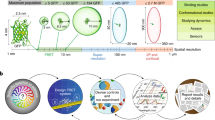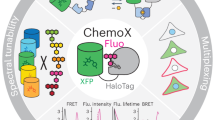Abstract
A substantial range of protein-protein interactions can be readily monitored in real time using bioluminescence resonance energy transfer (BRET). The procedure involves heterologous coexpression of fusion proteins, which link proteins of interest to a bioluminescent donor enzyme or acceptor fluorophore. Energy transfer between these proteins is then detected. This protocol encompasses BRET1, BRET2 and the recently described eBRET, including selection of the donor, acceptor and substrate combination, fusion construct generation and validation, cell culture, fluorescence and luminescence detection, BRET detection and data analysis. The protocol is particularly suited to studying protein-protein interactions in live cells (adherent or in suspension), but cell extracts and purified proteins can also be used. Furthermore, although the procedure is illustrated with references to mammalian cell culture conditions, this protocol can be readily used for bacterial or plant studies. Once fusion proteins are generated and validated, the procedure typically takes 48–72 h depending on cell culture requirements.
This is a preview of subscription content, access via your institution
Access options
Subscribe to this journal
Receive 12 print issues and online access
$259.00 per year
only $21.58 per issue
Buy this article
- Purchase on Springer Link
- Instant access to full article PDF
Prices may be subject to local taxes which are calculated during checkout


Similar content being viewed by others
References
Pfleger, K.D. & Eidne, K.A. Illuminating insights into protein-protein interactions using bioluminescence resonance energy transfer (BRET). Nat. Methods 3, 165–174 (2006).
Milligan, G. & Bouvier, M. Methods to monitor the quaternary structure of G-protein–coupled receptors. FEBS J. 272, 2914–2925 (2005).
Boute, N., Jockers, R. & Issad, T. The use of resonance energy transfer in high-throughput screening: BRET versus FRET. Trends Pharmacol. Sci. 23, 351–354 (2002).
Pfleger, K.D.G. & Eidne, K.A. New technologies: bioluminescence resonance energy transfer (BRET) for the detection of real time interactions involving G-protein coupled receptors. Pituitary 6, 141–151 (2003).
Wu, P. & Brand, L. Resonance energy transfer: methods and applications. Anal. Biochem. 218, 1–13 (1994).
Xu, Y., Piston, D.W. & Johnson, C.H. A bioluminescence resonance energy transfer (BRET) system: application to interacting circadian clock proteins. Proc. Natl. Acad. Sci. USA 96, 151–156 (1999).
Subramanian, C. et al. The Arabidopsis repressor of light signaling, COP1, is regulated by nuclear exclusion: mutational analysis by bioluminescence resonance energy transfer. Proc. Natl. Acad. Sci. USA 101, 6798–6802 (2004).
Angers, S. et al. Detection of beta 2-adrenergic receptor dimerization in living cells using bioluminescence resonance energy transfer (BRET). Proc. Natl. Acad. Sci. USA 97, 3684–3689 (2000).
Kroeger, K.M., Hanyaloglu, A.C., Seeber, R.M., Miles, L.E. & Eidne, K.A. Constitutive and agonist-dependent homo-oligomerization of the thyrotropin-releasing hormone receptor. Detection in living cells using bioluminescence resonance energy transfer. J. Biol. Chem. 276, 12736–12743 (2001).
Pfleger, K.D.G. & Eidne, K.A. Monitoring the formation of dynamic G-protein-coupled receptor-protein complexes in living cells. Biochem. J. 385, 625–637 (2005).
Scaffidi, A.K. et al. α(v)β(3) Integrin interacts with the transforming growth factor β (TGFβ) type II receptor to potentiate the proliferative effects of TGFβ1 in living human lung fibroblasts. J. Biol. Chem. 279, 37726–37733 (2004).
Brown, R.J. et al. Model for growth hormone receptor activation based on subunit rotation within a receptor dimer. Nat. Struct. Mol. Biol. 12, 814–821 (2005).
Michelini, E., Mirasoli, M., Karp, M., Virta, M. & Roda, A. Development of a bioluminescence resonance energy-transfer assay for estrogen-like compound in vivo monitoring. Anal. Chem. 76, 7069–7076 (2004).
Garside, H. et al. Glucocorticoid ligands specify different interactions with NF-kappaB by allosteric effects on the glucocorticoid receptor DNA binding domain. J. Biol. Chem. 279, 50050–50059 (2004).
de Virgilio, M., Kiosses, W.B. & Shattil, S.J. Proximal, selective, and dynamic interactions between integrin alphaIIbbeta3 and protein tyrosine kinases in living cells. J. Cell. Biol. 165, 305–311 (2004).
Yung, T.M., Sato, S. & Satoh, M.S. Poly(ADP-ribosyl)ation as a DNA damage-induced post-translational modification regulating poly(ADP-ribose) polymerase-1-topoisomerase I interaction. J. Biol. Chem. 279, 39686–39696 (2004).
Trevaskis, J. et al. Src homology 3-domain growth factor receptor-bound 2-like (endophilin) interacting protein 1, a novel neuronal protein that regulates energy balance. Endocrinology 146, 3757–3764 (2005).
Germain-Desprez, D., Bazinet, M., Bouvier, M. & Aubry, M. Oligomerization of transcriptional intermediary factor 1 regulators and interaction with ZNF74 nuclear matrix protein revealed by bioluminescence resonance energy transfer in living cells. J. Biol. Chem. 278, 22367–22373 (2003).
Terrillon, S. et al. Oxytocin and vasopressin V1a and V2 receptors from constitutive homo- and heterodimers during biosynthesis. Mol. Endocrinol. 17, 677–691 (2003).
Mercier, J.F., Salahpour, A., Angers, S., Breit, A. & Bouvier, M. Quantitative assessment of β1- and β2-adrenergic receptor homo- and heterodimerization by bioluminescence resonance energy transfer. J. Biol. Chem. 277, 44925–44931 (2002).
Ayoub, M.A. et al. Monitoring of ligand-independent dimerization and ligand-induced conformational changes of melatonin receptors in living cells by bioluminescence resonance energy transfer. J. Biol. Chem. 277, 21522–21528 (2002).
Hamdan, F.F., Audet, M., Garneau, P., Pelletier, J. & Bouvier, M. High-throughput screening of G protein-coupled receptor antagonists using a bioluminescence resonance energy transfer 1–based β-arrestin2 recruitment assay. J. Biomol. Screen. 10, 463–475 (2005).
Pfleger, K.D. et al. Extended bioluminescence resonance energy transfer (eBRET) for monitoring prolonged protein-protein interactions in live cells. Cell. Signal; Advance online publication 21 February 2006 (doi: 10.1016/j.cellsig.2006.01.004).
De, A. & Gambhir, S.S. Noninvasive imaging of protein-protein interactions from live cells and living subjects using bioluminescence resonance energy transfer. FASEB J. 19, 2017–2019 (2005).
Author information
Authors and Affiliations
Corresponding author
Ethics declarations
Competing interests
The authors declare no competing financial interests.
Rights and permissions
About this article
Cite this article
Pfleger, K., Seeber, R. & Eidne, K. Bioluminescence resonance energy transfer (BRET) for the real-time detection of protein-protein interactions. Nat Protoc 1, 337–345 (2006). https://doi.org/10.1038/nprot.2006.52
Published:
Issue Date:
DOI: https://doi.org/10.1038/nprot.2006.52
This article is cited by
-
The oncogene AAMDC links PI3K-AKT-mTOR signaling with metabolic reprograming in estrogen receptor-positive breast cancer
Nature Communications (2021)
-
Using nanoBRET and CRISPR/Cas9 to monitor proximity to a genome-edited protein in real-time
Scientific Reports (2017)
-
Split GFP technologies to structurally characterize and quantify functional biomolecular interactions of FTD-related proteins
Scientific Reports (2017)
-
An ultrasensitive NanoLuc-based luminescence system for monitoring Plasmodium berghei throughout its life cycle
Malaria Journal (2016)
Comments
By submitting a comment you agree to abide by our Terms and Community Guidelines. If you find something abusive or that does not comply with our terms or guidelines please flag it as inappropriate.



